Abstract
The wild-type strain of Pseudomonas fluorescens was found to utilize a range of structurally diverse organophosphonates as its sole carbon or nitrogen sources. Representative compounds included aminoalkylphosphonates, hydroxyalkylphosphonates, oxoalkylphosphonates, and phosphono dipeptides. Among them, amino(phenyl)methylphosphonate,2-aminoethylphosphonate, aminomethylphosphonate, diisopropyl 9-aminofluoren-9-ylphosphonate, and 2-oxoalkylphosphonates were used by P. fluorescens as its sole sources of phosphorus. Only slight growth was observed on the herbicide glyphosate (N-phosphonomethylglycine), which was metabolized to aminomethylphosphonate. Neither phosphinothricin nor its dialanyl tripeptide, bialaphos, supported growth of P. fluorescens. The possible mechanisms of organophosphonate degradation by this strain are discussed.
Full text
PDF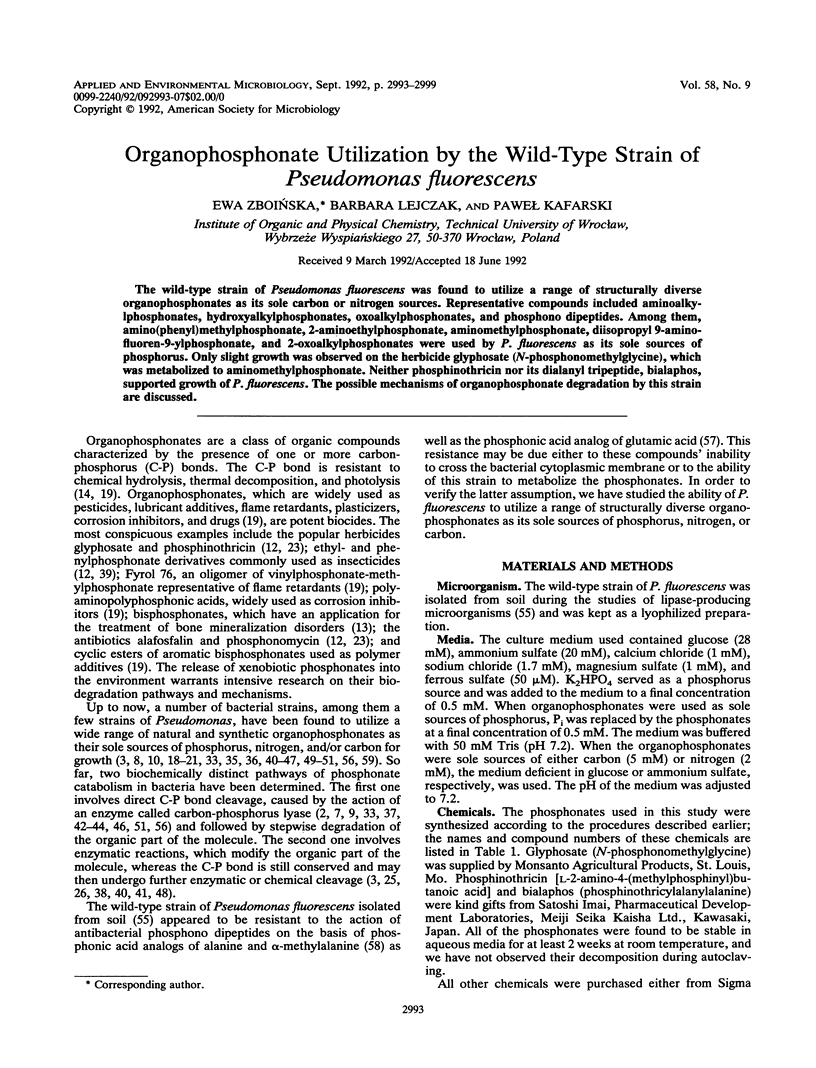
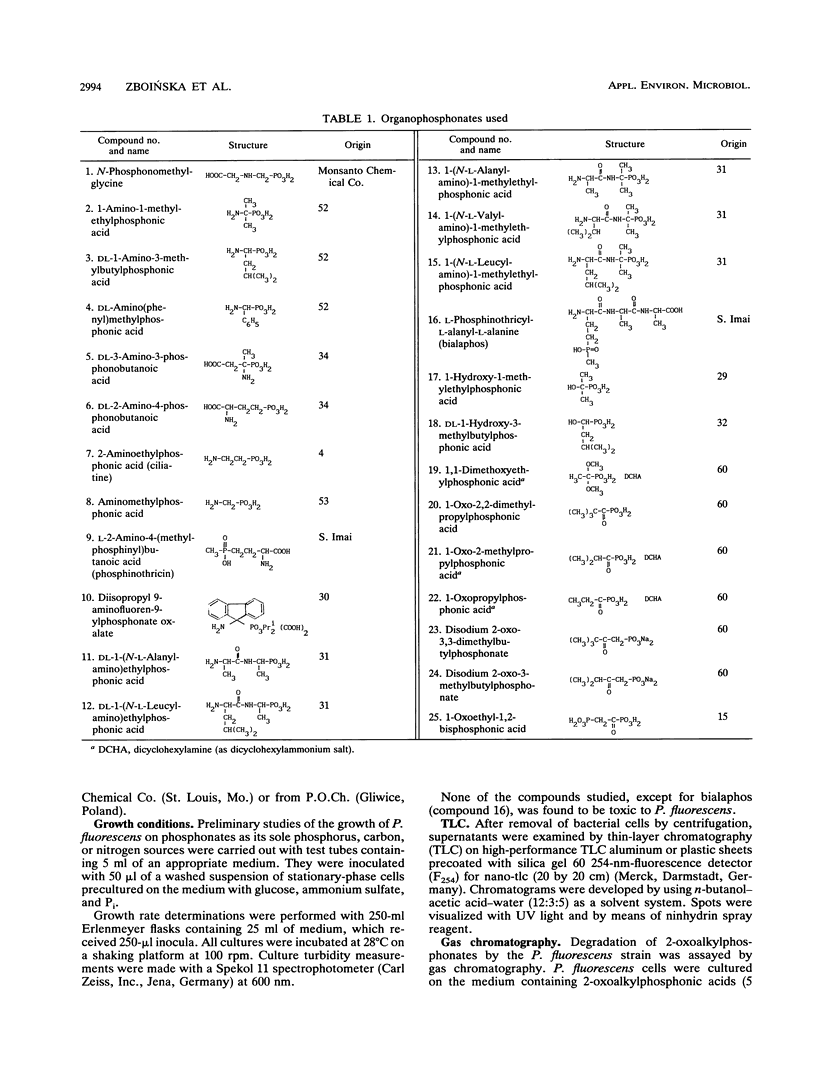
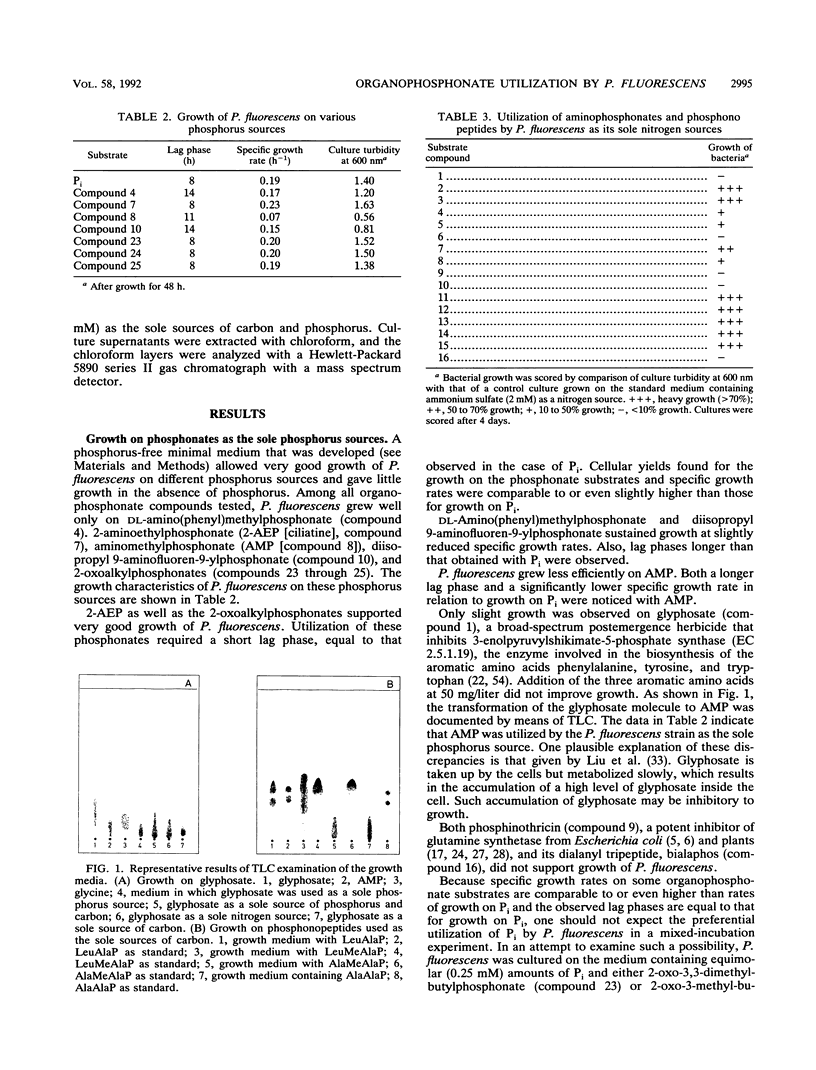
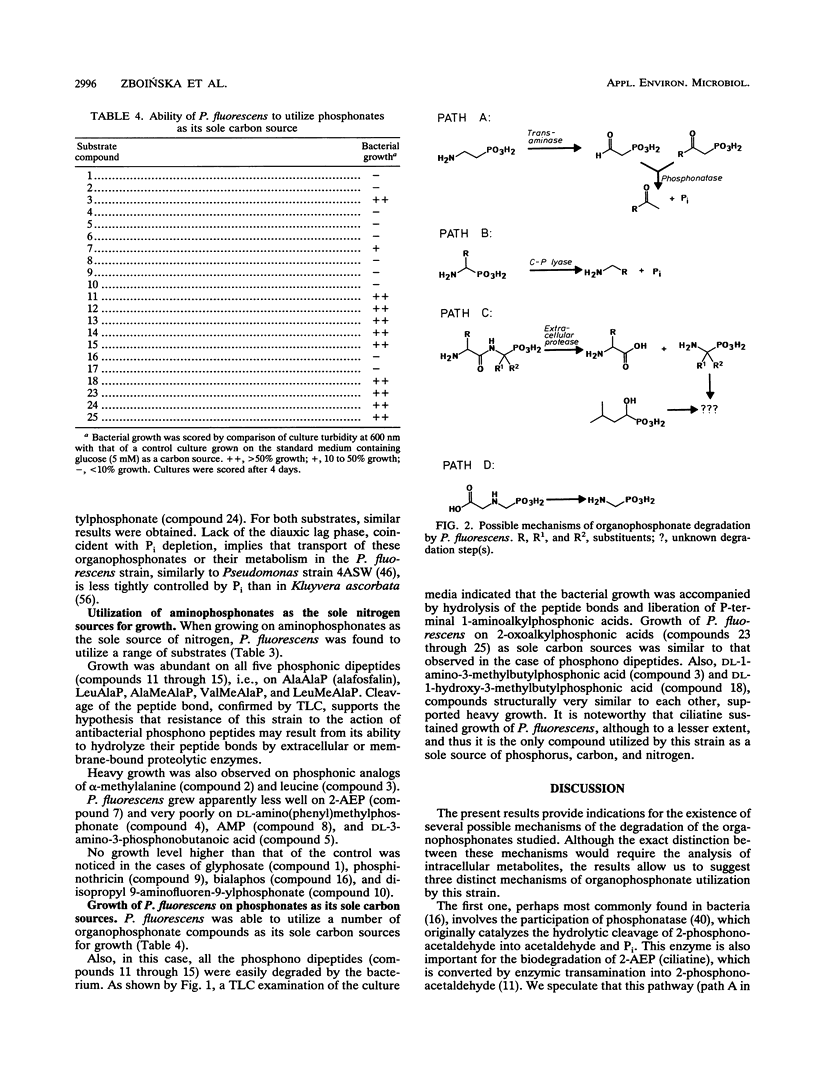

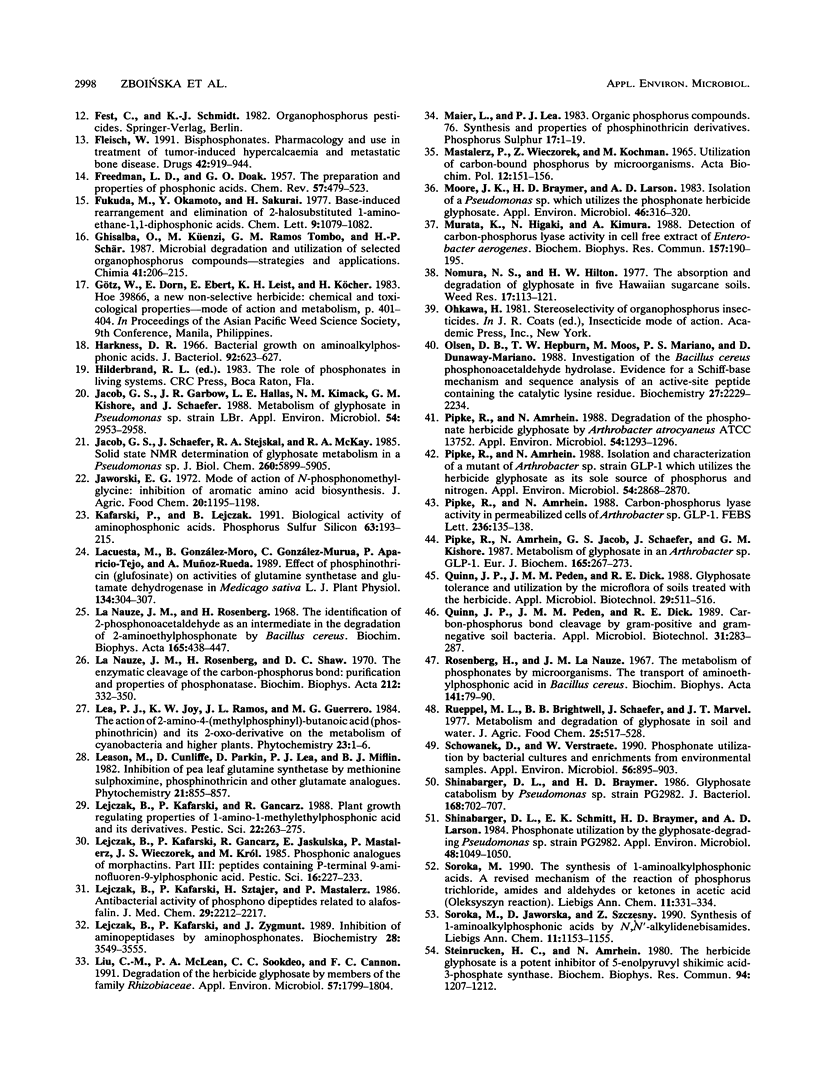

Selected References
These references are in PubMed. This may not be the complete list of references from this article.
- Balthazor T. M., Hallas L. E. Glyphosate-degrading microorganisms from industrial activated sludge. Appl Environ Microbiol. 1986 Feb;51(2):432–434. doi: 10.1128/aem.51.2.432-434.1986. [DOI] [PMC free article] [PubMed] [Google Scholar]
- Bayer E., Gugel K. H., Hägele K., Hagenmaier H., Jessipow S., König W. A., Zähner H. Stoffwechselprodukte von Mikroorganismen. 98. Phosphinothricin und Phosphinothricyl-Alanyl-Alanin. Helv Chim Acta. 1972 Jan 31;55(1):224–239. doi: 10.1002/hlca.19720550126. [DOI] [PubMed] [Google Scholar]
- Chen C. M., Ye Q. Z., Zhu Z. M., Wanner B. L., Walsh C. T. Molecular biology of carbon-phosphorus bond cleavage. Cloning and sequencing of the phn (psiD) genes involved in alkylphosphonate uptake and C-P lyase activity in Escherichia coli B. J Biol Chem. 1990 Mar 15;265(8):4461–4471. [PubMed] [Google Scholar]
- Cook A. M., Daughton C. G., Alexander M. Phosphonate utilization by bacteria. J Bacteriol. 1978 Jan;133(1):85–90. doi: 10.1128/jb.133.1.85-90.1978. [DOI] [PMC free article] [PubMed] [Google Scholar]
- Dumora C., Lacoste A. M., Cassaigne A. Purification and properties of 2-aminoethylphosphonate:pyruvate aminotransferase from Pseudomonas aeruginosa. Eur J Biochem. 1983 Jun 1;133(1):119–125. doi: 10.1111/j.1432-1033.1983.tb07436.x. [DOI] [PubMed] [Google Scholar]
- Fleisch H. Bisphosphonates. Pharmacology and use in the treatment of tumour-induced hypercalcaemic and metastatic bone disease. Drugs. 1991 Dec;42(6):919–944. doi: 10.2165/00003495-199142060-00003. [DOI] [PubMed] [Google Scholar]
- Harkness D. R. Bacterial growth on aminoalkylphosphonic acids. J Bacteriol. 1966 Sep;92(3):623–627. doi: 10.1128/jb.92.3.623-627.1966. [DOI] [PMC free article] [PubMed] [Google Scholar]
- Jacob G. S., Garbow J. R., Hallas L. E., Kimack N. M., Kishore G. M., Schaefer J. Metabolism of glyphosate in Pseudomonas sp. strain LBr. Appl Environ Microbiol. 1988 Dec;54(12):2953–2958. doi: 10.1128/aem.54.12.2953-2958.1988. [DOI] [PMC free article] [PubMed] [Google Scholar]
- Jacob G. S., Schaefer J., Stejskal E. O., McKay R. A. Solid-state NMR determination of glyphosate metabolism in a Pseudomonas sp. J Biol Chem. 1985 May 25;260(10):5899–5905. [PubMed] [Google Scholar]
- La Nauze J. M., Rosenberg H., Shaw D. C. The enzymic cleavage of the carbon-phosphorus bond: purification and properties of phosphonatase. Biochim Biophys Acta. 1970 Aug 15;212(2):332–350. doi: 10.1016/0005-2744(70)90214-7. [DOI] [PubMed] [Google Scholar]
- La Nauze J. M., Rosenberg H. The identification of 2-phosphonoacetaldehyde as an intermediate in the degradation of 2-aminoethylphosphonate by Bacillus cereus. Biochim Biophys Acta. 1968 Oct 15;165(3):438–447. doi: 10.1016/0304-4165(68)90223-7. [DOI] [PubMed] [Google Scholar]
- Lejczak B., Kafarski P., Sztajer H., Mastalerz P. Antibacterial activity of phosphono dipeptides related to alafosfalin. J Med Chem. 1986 Nov;29(11):2212–2217. doi: 10.1021/jm00161a014. [DOI] [PubMed] [Google Scholar]
- Lejczak B., Kafarski P., Zygmunt J. Inhibition of aminopeptidases by aminophosphonates. Biochemistry. 1989 Apr 18;28(8):3549–3555. doi: 10.1021/bi00434a060. [DOI] [PubMed] [Google Scholar]
- Liu C-M, McLean P. A., Sookdeo C. C., Cannon F. C. Degradation of the Herbicide Glyphosate by Members of the Family Rhizobiaceae. Appl Environ Microbiol. 1991 Jun;57(6):1799–1804. doi: 10.1128/aem.57.6.1799-1804.1991. [DOI] [PMC free article] [PubMed] [Google Scholar]
- MASTALERZ P., WIECZOREK Z., KOCHMAN M. UTILIZATION OF CARBON-BOUND PHOSPHORUS BY MICROORGANISMS. Acta Biochim Pol. 1965;12:151–156. [PubMed] [Google Scholar]
- Moore J. K., Braymer H. D., Larson A. D. Isolation of a Pseudomonas sp. Which Utilizes the Phosphonate Herbicide Glyphosate. Appl Environ Microbiol. 1983 Aug;46(2):316–320. doi: 10.1128/aem.46.2.316-320.1983. [DOI] [PMC free article] [PubMed] [Google Scholar]
- Murata K., Higaki N., Kimura A. Detection of carbon-phosphorus lyase activity in cell free extracts of Enterobacter aerogenes. Biochem Biophys Res Commun. 1988 Nov 30;157(1):190–195. doi: 10.1016/s0006-291x(88)80031-7. [DOI] [PubMed] [Google Scholar]
- Olsen D. B., Hepburn T. W., Moos M., Mariano P. S., Dunaway-Mariano D. Investigation of the Bacillus cereus phosphonoacetaldehyde hydrolase. Evidence for a Schiff base mechanism and sequence analysis of an active-site peptide containing the catalytic lysine residue. Biochemistry. 1988 Mar 22;27(6):2229–2234. doi: 10.1021/bi00406a063. [DOI] [PubMed] [Google Scholar]
- Pipke R., Amrhein N. Degradation of the Phosphonate Herbicide Glyphosate by Arthrobacter atrocyaneus ATCC 13752. Appl Environ Microbiol. 1988 May;54(5):1293–1296. doi: 10.1128/aem.54.5.1293-1296.1988. [DOI] [PMC free article] [PubMed] [Google Scholar]
- Pipke R., Amrhein N. Isolation and Characterization of a Mutant of Arthrobacter sp. Strain GLP-1 Which Utilizes the Herbicide Glyphosate as Its Sole Source of Phosphorus and Nitrogen. Appl Environ Microbiol. 1988 Nov;54(11):2868–2870. doi: 10.1128/aem.54.11.2868-2870.1988. [DOI] [PMC free article] [PubMed] [Google Scholar]
- Pipke R., Amrhein N., Jacob G. S., Schaefer J., Kishore G. M. Metabolism of glyphosate in an Arthrobacter sp. GLP-1. Eur J Biochem. 1987 Jun 1;165(2):267–273. doi: 10.1111/j.1432-1033.1987.tb11437.x. [DOI] [PubMed] [Google Scholar]
- Rosenberg H., La Nauze J. M. The metabolism of phosphonates by microorganisms. The transport of aminoethylphosphonic acid in Bacillus cereus. Biochim Biophys Acta. 1967 Jun 13;141(1):79–90. doi: 10.1016/0304-4165(67)90247-4. [DOI] [PubMed] [Google Scholar]
- Rueppel M. L., Brightwell B. B., Schaefer J., Marvel J. T. Metabolism and degradation of glyphosphate in soil and water. J Agric Food Chem. 1977 May-Jun;25(3):517–528. doi: 10.1021/jf60211a018. [DOI] [PubMed] [Google Scholar]
- Schowanek D., Verstraete W. Phosphonate utilization by bacterial cultures and enrichments from environmental samples. Appl Environ Microbiol. 1990 Apr;56(4):895–903. doi: 10.1128/aem.56.4.895-903.1990. [DOI] [PMC free article] [PubMed] [Google Scholar]
- Shinabarger D. L., Braymer H. D. Glyphosate catabolism by Pseudomonas sp. strain PG2982. J Bacteriol. 1986 Nov;168(2):702–707. doi: 10.1128/jb.168.2.702-707.1986. [DOI] [PMC free article] [PubMed] [Google Scholar]
- Shinabarger D. L., Schmitt E. K., Braymer H. D., Larson A. D. Phosphonate Utilization by the Glyphosate-Degrading Pseudomonas sp. Strain PG2982. Appl Environ Microbiol. 1984 Nov;48(5):1049–1050. doi: 10.1128/aem.48.5.1049-1050.1984. [DOI] [PMC free article] [PubMed] [Google Scholar]
- Steinrücken H. C., Amrhein N. The herbicide glyphosate is a potent inhibitor of 5-enolpyruvyl-shikimic acid-3-phosphate synthase. Biochem Biophys Res Commun. 1980 Jun 30;94(4):1207–1212. doi: 10.1016/0006-291x(80)90547-1. [DOI] [PubMed] [Google Scholar]
- Wackett L. P., Shames S. L., Venditti C. P., Walsh C. T. Bacterial carbon-phosphorus lyase: products, rates, and regulation of phosphonic and phosphinic acid metabolism. J Bacteriol. 1987 Feb;169(2):710–717. doi: 10.1128/jb.169.2.710-717.1987. [DOI] [PMC free article] [PubMed] [Google Scholar]
- ZELEZNICK L. D., MYERS T. C., TITCHENER E. B. GROWTH OF ESCHERICHIA COLI ON METHYL- AND ETHYLPHOSPHONIC ACIDS. Biochim Biophys Acta. 1963 Nov 15;78:546–547. doi: 10.1016/0006-3002(63)90921-1. [DOI] [PubMed] [Google Scholar]
- Zboińska E., Sztajer H., Lejczak B., Kafarski P. Antibacterial activity of phosphono dipeptides based on 1-amino-1-methylethanephosphonic acid. FEMS Microbiol Lett. 1990 Jun 15;58(1):23–28. doi: 10.1111/j.1574-6968.1990.tb03770.x. [DOI] [PubMed] [Google Scholar]


